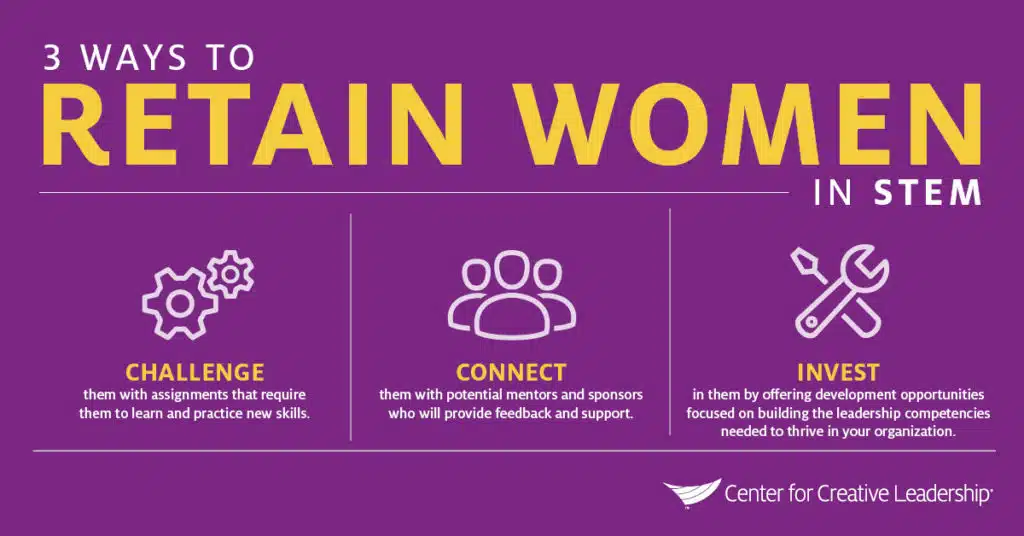Just 25% of Women in Tech Get the Support They Need
In today’s technology-dependent world, workers with strong technology skills are in high demand. Strong technology skills are critical for driving innovation, creating operational efficiencies, and establishing a marketplace advantage. As a result, competition for top talent is fierce — and getting fiercer.
Yet the 80:20 male-to-female ratio in science, technology, engineering, and math (STEM) fields remains about the same now as it was 25 years ago. Why, and what can we do?
2/3 of Women in Tech Quit Within 15 Years
Though women continue to make gains across the broader economy, they remain dramatically underrepresented in STEM positions:
- Women occupy less than 15% of executive roles in the technology sector, according to the federal Bureau of Labor Statistics.
- Women who receive STEM degrees are less likely than their male counterparts to work in STEM jobs.
- More than half the women working in STEM fields leave for other careers — and almost 1/3 leave within their first year on the job. Often, work experiences impact the decision to leave — including a feeling of isolation, hostile work environments, and a lack of supportive sponsors.
- Those who stay typically peak about 10-15 years into their careers — failing to move into senior management or the executive suite.
Yet according to data from the Center for Talent Innovation, more than 75% of young women engineers, computer scientists, and other technologists describe themselves as “very ambitious,” with 85% gunning for a promotion in the next 3 years, and 62% aspiring to one day reach the C-suite. Just 25% of young women in the tech industry say they get the career support they’ve been promised.
Despite the young women’s commitment and enthusiasm, about 2/3 of women engineers leave the profession within 15 years, and that statistic is even more pronounced for women on the technical track (who pursue high-level technical contributions, versus general management roles).
Why So Many Women Leave STEM Careers
A wealth of data show that women are subject to biases that discourage them from advancing and even lead them to leave the tech sector.
What’s particularly important about that 80:20 male-to-female ratio in the tech industry is that the research consistently shows a widespread desire to be surrounded by white male engineers or computer scientists, and the consequent rejection or minimization of the contributions of minority groups who are seen as different or “diverse” (like women and people of color). This leads to exclusion from informal networks that enhance skills and provide useful insights into organizational politics.
These biases shape assumptions, perception of leadership skills, and advancement. When a woman’s excellence at a “soft” task is seen as “natural,” it’s less valued and not considered a noteworthy achievement. In contrast, an adequate performance by men in stereotypically “feminine” or “soft” skills like nurturing, emotional expressiveness, and communication is considered exceptional — leading to better ratings, faster promotions, and higher pay for them.
Which Women Stay in Tech?
Research has shown that women with staying power in STEM careers, as well as the women who rise to the top in the tech industry, have a strong sense of self-efficacy, are passionate about their work, have positive support at work, are loyal to their team and others, and cultivate strong personal and professional networks.
It may seem logical that if you take people who are passionate about what they do, provide them with challenging work and the needed support, and enable strong networks, they’ll be likely to prosper. But most women in tech still drop out of the industry.
Companies have spent decades trying to support women in tech by addressing their widespread departures, but the tide hasn’t turned yet. What’s going on? What do women need in order to stay and succeed? What do organizations need to do to keep these talented women in the field?
Advancing & Supporting Women in Tech: What Organizations Can Do
As noted in our white paper, there’s much more organizations can do to show they’re supporting women in tech. First, they can build a more inclusive organizational culture; and secondly, they can make a conscious effort to retain women leaders.
Build a More Inclusive Culture
Clearly, there’s more that firms can do in terms of supporting women in the tech industry.
First, organizations can rigorously review and update their diversity and inclusion initiatives to ensure they’re focused first on equity. They can educate everyone in the organization about unconscious bias – practices and behaviors that appear to be neutral, but which actually harm marginalized groups — and have the tough conversations about evolving their organizational culture so it’s more oriented towards equity, diversity, and inclusion.
3 Keys to Supporting Women in the Tech Industry
Second, there are 3 important actions tech companies can take to signal their support of women leaders:
These 3 steps will help improve retention of talented women leaders:
- Challenge them with assignments that require them to learn and practice new skills.
- Connect them with potential mentors and sponsors who will provide feedback and support.
- Invest in them by offering formalized leadership development opportunities for women leaders focused on building the leadership competencies needed to thrive in your organization.
What Women in Tech Themselves Can Do
While the tech industry is beginning to focus more on supporting women leaders, women who want to be successful in the tech industry and ascend to leadership positions should also focus on what they can do themselves to avoid mid-career stalls. Women in STEM who are aspiring to leadership positions should focus on:
- Knowing your self-worth.
- Finding creative ways to grow.
- Building a network with sponsors.
Here’s how to get started with each.
1. Know your self-worth. Men and women often think about their readiness for new opportunities in different ways.
Research has found that men are likely to say they’re ready to take on a new challenge when they feel they have about 60% of the knowledge and skills they need. Women, by contrast, are more likely to wait until they feel they are 90% there. To advance, women need to say “Yes” more often and more quickly.
But how do women find the courage to say “Yes” when they don’t feel 90% ready? One key is for women to stay connected to understand how they can contribute.
Top women tech leaders are passionate about what their companies do, what their teams are doing, and what they do. Women in leadership roles in the tech industry should understand their value and know what they want. So:
- Get clear on the real value you bring to your work, your team, and the organization.
- Be able to articulate your value and declare your passion and goals to others. This is part of authentic self-promotion.
- Ask close colleagues for feedback on your strengths and growth opportunities.
- Look for people who can be bridge-builders to help you find challenging stretch assignments, new roles, or valuable connections with more senior leaders in the organization.
2. Find creative ways to grow. Leaders need to find ways to learn new skills and connect with new people to grow professionally.
Women generally get markedly easier stretch assignments. But senior tech leaders need business acumen, negotiation skills, and political savvy. Challenging stretch assignments provide better opportunities to develop those skills. Women in the industry must receive more opportunities with a focus on these hard leadership skills.
Growth opportunities can include “extra” responsibilities, such as presenting on behalf of the company at a conference or serving on an industry technical standards committee. (If you struggle with networking, you’re not alone. Check out our networking tips for women.)
Women engineers need to also make sure they’re successful with these opportunities and that they get credit for them. That might mean, for example, finding a mentor to advise you on approaching the challenge in a new way and to champion you as you do things in ways you haven’t before. You’ll also want trusted colleagues to provide honest feedback.
Some women may feel that by asking for support, they’re revealing weaknesses that might hurt their prospects for advancement. Women need to find a way to quiet those inner voices and make sure they get the support they need to be successful, and that they are recognized for their accomplishments.
A network of sponsors is especially helpful in that regard.
3. Build a network with sponsors. Networking is widely regarded as critical for career development, but building a network of champions, including mentors and sponsors, is especially important for supporting women in the tech industry.
A sponsor is not just another person in your network; it’s someone who has the power and knowledge to recommend you. But building those relationships can be tough.
In a workforce that is predominantly male, for example, the social interactions where professional networks develop may take place in environments that aren’t always comfortable for women.
Some companies and managers are improving at removing those implicit biases. They might encourage breakfast meetings instead of drinks after work, for example. But this also means that women may need to “hack” their own paths to build their network of sponsors, such as meeting people one-on-one and doing informational interviews. They may also need to look outside the company for key relationships. In Silicon Valley, for example, there are a number of networking groups for women in technology.
And women shouldn’t forget opportunities to help one another. After all, women need to support women. At many large, well-known technology companies, one woman started an internal women’s resource group or mentoring program, which then later grew into a large, more formalized program supporting women in tech.
Ready to Take the Next Step?
Organizations that are serious about supporting women in the tech industry can provide their talented women leaders with access to women’s leadership development. Our experts in technology and leadership can partner with your company to build a more equitable, diverse, and inclusive organizational culture for all your talent.









